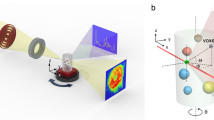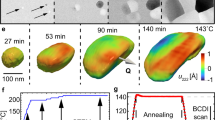Abstract
X-ray microscopy is powerful in that it can probe large volumes of material at high spatial resolution with exquisite chemical, electronic and bond orientation contrast1,2,3,4,5. The development of diffraction-based methods such as ptychography has, in principle, removed the resolution limit imposed by the characteristics of the X-ray optics6,7,8,9,10. Here, using soft X-ray ptychography, we demonstrate the highest-resolution X-ray microscopy ever achieved by imaging 5 nm structures. We quantify the performance of our microscope and apply the method to the study of delithiation in a nanoplate of LiFePO4, a material of broad interest in electrochemical energy storage11,12. We calculate chemical component distributions using the full complex refractive index and demonstrate enhanced contrast, which elucidates a strong correlation between structural defects and chemical phase propagation. The ability to visualize the coupling of the kinetics of a phase transformation with the mechanical consequences is critical to designing materials with ultimate durability.
This is a preview of subscription content, access via your institution
Access options
Subscribe to this journal
Receive 12 print issues and online access
$209.00 per year
only $17.42 per issue
Buy this article
- Purchase on Springer Link
- Instant access to full article PDF
Prices may be subject to local taxes which are calculated during checkout




Similar content being viewed by others
References
Kirz, J., Jacobsen, C. & Howells, M. Soft X-ray microscopes and their biological applications. Q. Rev. Biophys. 28, 33–130 (1995).
Ade, H. & Stoll, H. Near-edge X-ray absorption fine-structure microscopy of organic and magnetic materials. Nature Mater. 8, 281–290 (2009).
Chao, W., Kim, J., Rekawa, S., Fischer, P. & Anderson, E. H. Demonstration of 12 nm resolution Fresnel zone plate lens based soft X-ray microscopy. Opt. Express 17, 17669–17677 (2009).
Rehbein, S., Heim, S., Guttmann, P., Werner, S. & Schneider, G. Ultrahigh-resolution soft-X-ray microscopy with zone plates in high orders of diffraction. Phys. Rev. Lett. 103, 110801 (2009).
Vila-Comamala, J. et al. Zone-doubled Fresnel zone plates for high-resolution hard X-ray full-field transmission microscopy. J. Synchrotron Radiat. 19, 705–709 (2012).
Rodenburg, J. M. et al. Hard-X-ray lensless imaging of extended objects. Phys. Rev. Lett. 98 034801 (2007).
Thibault, P. et al. High-resolution scanning X-ray diffraction microscopy. Science 321, 379–382 (2008).
Dierolf, M. et al. Ptychographic X-ray computed tomography at the nanoscale. Nature 467, 436–439 (2010).
Holler, M. et al. An instrument for 3D X-ray nano-imaging. Rev. Sci. Instrum. 83, 073703 (2012).
Schropp, A. et al. Hard X-ray scanning microscopy with coherent radiation: beyond the resolution of conventional X-ray microscopes. Appl. Phys. Lett. 100, 253112 (2012).
Kang, B. & Ceder, G. Battery materials for ultrafast charging and discharging. Nature 458, 190–193 (2009).
Tarascon, J.-M. Key challenges in future Li-battery research. Phil. Trans. R. Soc. Math. Phys. Eng. Sci. 368, 3227–3241 (2010).
Thibault, P., Dierolf, M., Bunk, O., Menzel, A. & Pfeiffer, F. Probe retrieval in ptychographic coherent diffractive imaging. Ultramicroscopy 109, 338–343 (2009).
Howells, M. R. et al. An assessment of the resolution limitation due to radiation-damage in X-ray diffraction microscopy. J. Electron Spectrosc. Relat. Phenom. 170, 4–12 (2009).
Kilcoyne, D. et al. A new scanning transmission X-ray microscope at the ALS for operation up to 2500 eV. AIP Conference Proceedings Vol 1234, 465–468 (2010).
Bluhm, H. et al. Soft X-ray microscopy and spectroscopy at the molecular environmental science beamline at the Advanced Light Source. J. Electron Spectrosc. Relat. Phenom. 150, 86–104 (2006).
Kilcoyne, A. L. D. et al. Interferometer-controlled scanning transmission X-ray microscopes at the Advanced Light Source. J. Synchrotron Radiat. 10, 125–136 (2003).
Marchesini, S., Schirotzek, A., Yang, C., Wu, H. & Maia, F. Augmented projections for ptychographic imaging. Inverse Problems 29, 115009 (2013).
Yashchuk, V. V. et al. Characterization of electron microscopes with binary pseudo-random multilayer test samples. Nucl. Instrum. Methods Phys. Res. A 649, 150–152 (2011).
Jacobsen, C. et al. Diffraction-limited imaging in a scanning transmission X-ray microscope. Opt. Commun. 86, 351–364 (1991).
Yuan, L.-X. et al. Development and challenges of LiFePO4 cathode material for lithium-ion batteries. Energy Environ. Sci. 4, 269–284 (2011).
Malik, R., Aziz, A. & Ceder, G. A critical review of the Li insertion mechanisms in LiFePO4 electrodes. J. Electrochem. Soc. 160, A3179–A3197 (2013).
Boesenberg, U. et al. Mesoscale phase distribution in single particles of LiFePO4 following lithium deintercalation. Chem. Mater. 25, 1664–1672 (2013).
Moreau, P., Mauchamp, V., Pailloux, F. & Boucher, F. Fast determination of phases in LixFePO4 using low losses in electron energy-loss spectroscopy. Appl. Phys. Lett. 94, 123111 (2009).
Lerotic, M., Jacobsen, C., Schafer, T. & Vogt, S. Cluster analysis of soft X-ray spectromicroscopy data. Ultramicroscopy 100, 35–37 (2004).
Chen, G., Song, X. & Richardson, T. J. Electron microscopy study of the LiFePO4 to FePO4 phase transition. Electrochem. Solid-State Lett. 9, A295–A298 (2006).
Denes, P., Doering, D., Padmore, H. A., Walder, J.-P. & Weizeorick, J. A fast, direct X-ray detection charge-coupled device. Rev. Sci. Instrum. 80, 083302 (2009).
Luke, D. R. Relaxed averaged alternating reflections for diffraction imaging. Inverse Problems 21, 37–50 (2005).
Dokko, K., Koizumi, S., Nakano, H. & Kanamura, K. Particle morphology, crystal orientation, and electrochemical reactivity of LiFePO4 synthesized by the hydrothermal method at 443 K. J. Mater. Chem. 17, 4803–4810 (2007).
Acknowledgements
All measurements were carried out at either beamline 11.0.2 or beamline 5.3.2.1 at the Advanced Light Source (ALS). The ALS is supported by the Director, Office of Science, Office of Basic Energy Sciences, of the US Department of Energy (contract no. DE-AC02-05CH11231). The authors acknowledge the support of ALS technical and safety staff and discussions with J. Kirz and J. Spence. This work is partially supported by the Center for Applied Mathematics for Energy Research Applications (CAMERA), which is a partnership between Basic Energy Sciences (BES) and Advanced Scientific Computing Research (ASRC) at the US Department of Energy. The chemical imaging work on LiFePO4 carried out by Y.S.Y., J.C. and Y.S.M. was supported as part of the Northeastern Center for Chemical Energy Storage, an Energy Frontier Research Center funded by the US Department of Energy, Office of Science, Office of Basic Energy Sciences (award no. DE-SC0001294). The authors thank G. Chen (LBNL) for supplying the delithiated LiFePO4 sample. J.C. thanks T. Richardson and R. Kostecki (LBNL) for technical discussions.
Author information
Authors and Affiliations
Contributions
D.A.S., S.M., T.T., K.K., H.P., T.W. and J.C. conceived and planned the experiment. D.A.S., S.M., T.T., R.C., A.S., D.K., T.W., W.C. and L.Y. developed experimental techniques, software and equipment. W.C. and Y.S.Y. prepared the samples. D.A.S., T.T., K.K., D.K. and Y.S.Y. carried out the measurements. D.A.S., S.M. and F.M. developed data processing and ptychography reconstruction codes. D.A.S. and Y.S.Y. performed post-experiment data analysis and Y.S.Y., Y.S.M. and J.C. established the interpretation of the chemical maps. D.A.S., Y.S.Y. and J.C. prepared the manuscript, which incorporates input from all authors.
Corresponding author
Ethics declarations
Competing interests
The authors declare no competing financial interests.
Supplementary information
Supplementary information
Supplementary information (PDF 2430 kb)
Rights and permissions
About this article
Cite this article
Shapiro, D., Yu, YS., Tyliszczak, T. et al. Chemical composition mapping with nanometre resolution by soft X-ray microscopy. Nature Photon 8, 765–769 (2014). https://doi.org/10.1038/nphoton.2014.207
Received:
Accepted:
Published:
Issue Date:
DOI: https://doi.org/10.1038/nphoton.2014.207
This article is cited by
-
Nanoscale imaging of Fe-rich inclusions in single-crystal zircon using X-ray ptycho-tomography
Scientific Reports (2024)
-
Ultracompact mirror device for forming 20-nm achromatic soft-X-ray focus toward multimodal and multicolor nanoanalyses
Nature Communications (2024)
-
Visualizing the ultra-structure of microorganisms using table-top extreme ultraviolet imaging
PhotoniX (2023)
-
High-harmonic generation in CdTe with ultra-low pump intensity and high photon flux
Communications Physics (2023)
-
Direct high-resolution X-ray imaging exploiting pseudorandomness
Light: Science & Applications (2023)



